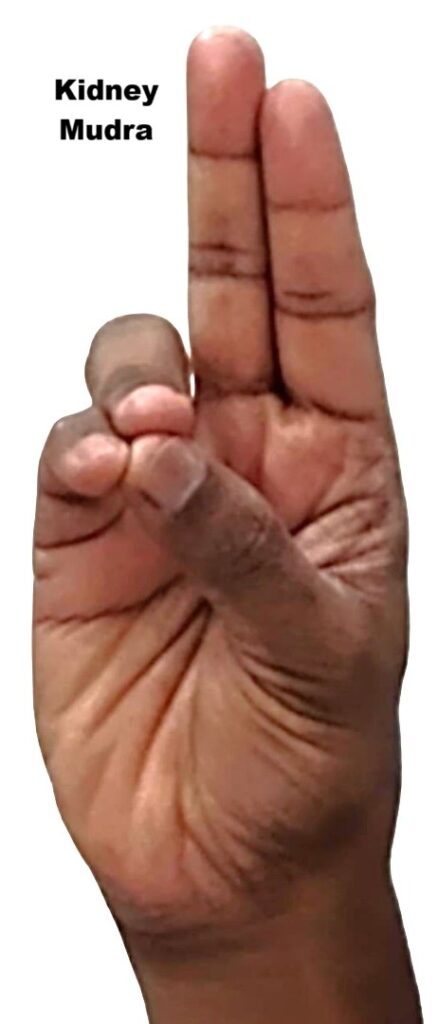Kidney Mudra
Introduction
Kidney Mudra is a powerful yogic hand gesture used in mudra therapy to balance the water element and restore vitality to the kidneys. In yogic and Ayurvedic philosophy, the kidneys are not only filters of toxins but also regulators of pranic energy, water metabolism, and emotional stability (especially fear and anxiety).
By pressing specific fingertips, this mudra activates pranic currents that stimulate kidney function, improve circulation, and regulate water–salt balance in the body. It is often recommended in naturopathy and yoga therapy for those suffering from kidney weakness, fatigue, dehydration, or fear-related emotional imbalances.
Meaning
Sanskrit: “Kidney” relates to vrikka in Ayurveda, which governs water regulation and vitality.
Kidney Mudra symbolically means “gesture that awakens kidney energy and water balance.”
It channels prana to the water element (apas tattva), strengthening the kidneys and urinary system.
How to Perform (Method of Practice)
Steps:
Sit in a comfortable meditative posture (Sukhasana, Padmasana, or Vajrasana) or even on a chair.
Relax shoulders and spine, keep eyes gently closed.
Place ring finger (earth element) and little finger (water element) tips on the thumb tip (fire element).
Keep the index and middle fingers extended, relaxed, and straight.
Rest hands on thighs with palms facing upward.
Breathe naturally, focusing on the kidney region (lower back) or the water element inside the body.
Benefits
Physical Benefits
Stimulates kidney function and supports detoxification.
Improves urination, water balance, and salt metabolism.
Reduces fatigue, dehydration, and dizziness.
May help in mild hypertension and water retention (edema).
Enhances vitality by improving prana circulation in the lower back.
Mental & Emotional Benefits
Reduces fear, insecurity, and anxiety (linked to kidney meridian in Traditional Chinese Medicine).
Promotes emotional stability and calmness.
Supports confidence and resilience.
Spiritual Benefits
Strengthens connection to Apas Tattva (water element).
Harmonizes Muladhara (root chakra) and Svadhisthana (sacral chakra).
Improves grounding, fluidity, and adaptability in life.
Contraindications
Not a substitute for medical treatment of kidney disease.
Avoid over-practice if suffering from severe renal failure, dialysis, or kidney stones – consult a doctor.
Pregnant women should practice only under expert guidance.
Should not replace hydration – water intake is still essential.
Anatomy & Physiology
Works through reflex zones of fingers, stimulating kidney-related nerve pathways.
The thumb (fire) controls metabolic processes, ring finger (earth) and little finger (water) help regulate fluids and stability.
Supports renal circulation, nephrons filtration, and hormonal regulation (renin, erythropoietin, vitamin D activation).
Kinesiology
The act of pressing ring and little fingers into the thumb creates isometric engagement of hand muscles.
Activates meridians and nadis connected to kidney energy (similar to acupressure points).
Enhances postural awareness when paired with straight spine and breath regulation.
Neurology
Finger pressure stimulates sensory and motor cortex representations of the hand, indirectly influencing kidney reflex zones.
Parasympathetic activation → relaxation and better renal blood flow.
May regulate hypothalamus–pituitary–adrenal axis (stress and fear regulation).
Duration of Practice
Therapeutic practice: 15–20 minutes, 2–3 times a day.
Preventive practice: 10 minutes daily in the morning.
Can be safely integrated with pranayama or meditation for deeper effects.
Counter Mudra
Apana Mudra: Helps detoxify and eliminate waste.
Varun Mudra: Enhances hydration and water element.
Prana Mudra: Restores overall vitality and supports kidney function.
Conclusion
Kidney Mudra is a simple yet profound yogic tool to activate kidney energy, restore water balance, and overcome fear-based emotions. It combines physical detoxification with emotional stability, making it highly relevant in today’s stressful lifestyle. While highly beneficial, it should be practiced alongside proper hydration, diet, medical care, and lifestyle balance.
FAQ
Q1: Can Kidney Mudra cure kidney disease?
It supports kidney function but does not replace medical treatment.
Q2: When is the best time to practice?
Morning or early evening, preferably on an empty stomach.
Q3: Can I practice it lying down?
Yes, but meditative sitting posture enhances results.
Q4: Does it help with fear and anxiety?
Yes, by balancing kidney energy and calming the nervous system.
Q5: How soon can results be felt?
Mild effects (relaxation, calmness) can be felt immediately; therapeutic benefits may take weeks.
References
Swami Satyananda Saraswati – Asana, Pranayama, Mudra, Bandha.
Gertrud Hirschi – Mudras: Yoga in Your Hands.
Mark Singleton & James Mallinson – Roots of Yoga.
Tiwari, O.P. – Pranayama: The Breath of Yoga.
Ayurvedic texts – Charaka Samhita (kidney and water balance references).
Traditional Chinese Medicine – Kidney Meridian studies.
